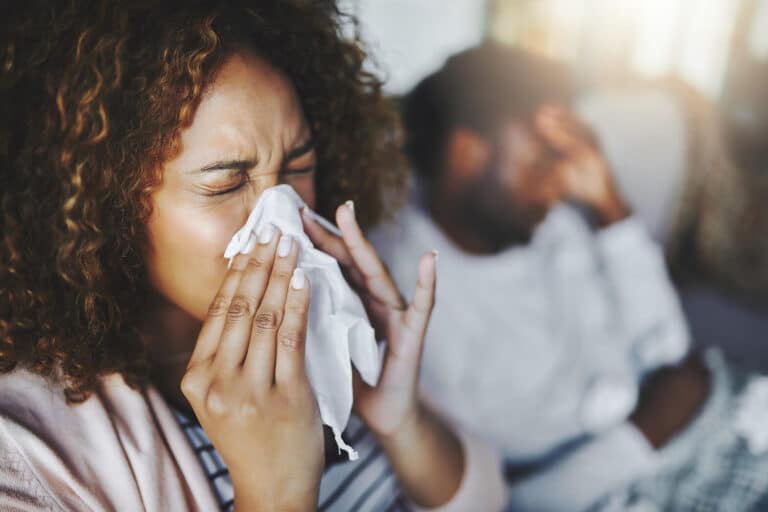Cellulitis is a bacterial infection of the deeper layers of the skin, which seems to occur when a wound or injury becomes infected. According to the Center for Disease Control and Prevention (CDC), different types of bacteria can cause cellulitis. Symptoms are painful, but a primary concern is getting cellulitis treatment early on because if the infection remains untreated, it can be potentially life-threatening.
Cellulitis typically affects the lower legs and feet. These areas of our body are more exposed to harmful bacteria and are sometimes more challenging to keep clean than other body parts. But it can impact any break in the skin anywhere on the body. Early signs and symptoms of cellulitis can differ quite a bit.
Here we explain everything you need to know about cellulitis, from causes and symptoms, to treatment and healing.
What are Early Cellulitis Symptoms?
Being aware of the early signs and symptoms of cellulitis may help you identify an infection quickly and treat it before it gets worse. This information will help you know when to contact your doctor and seek medical attention.
While cellulitis symptoms do vary, they can include:
- Redness that expands around the skin wound
- Swelling of the infected area
- Tight, glossy appearance of the area
- Pain and tenderness – sometimes the infected area feels warm to the touch
- Fever
- Red spots, blisters, and skin dimpling
Severe cellulitis symptoms include rapid growth of the infected area – regardless of whether the patient is experiencing fevers or chills.
What are the Causes of Cellulitis?
Two different types of bacteria typically cause cellulitis: staphylococcus and streptococcus. For either of these bacteria to reach the deeper layers of skin, there must be a break in the skin.
Common points of entry include:
- Injuries that cause a break in the skin like:
- Cuts
- Ulcers
- Bites
- Puncture wounds
- Tattoos and piercings
- Injection-based drug use
- Recent surgery incisions
- Chronic skin conditions, like athlete’s foot and eczema
- Chickenpox and shingles
- Cracked and dry skin
Certain pre-existing conditions can also increase your risk of contracting cellulitis. These include:
- A compromised or weakened immune system due to other conditions like HIV/AIDS, Diabetes, and Leukemia
- A history of cellulitis
- Obesity
Is Cellulitis Contagious?
It is not typically contagious since cellulitis is caused by a bacterial infection reaching the skin’s deep layers. With that being said, the bacteria that causes the infection is living on the skin, so it’s essential to keep skin breaks or wounds clean.
Can You Prevent Cellulitis?
If you have any open cuts, burns, surgical wounds, or any other break in the skin – including dry skin – you can do some things to prevent cellulitis, including:
- Keeping your wound clean by cleaning it daily with soap and water
- Applying protective ointment or cream
- Cover your injury with a bandage and change it daily
- Regularly check the wound for signs of infections, like redness, pain, swelling, and drainage – so you know when you need to contact your doctor
People who are at a higher risk of developing cellulitis symptoms can take additional preventative measures like:
- Regularly inspecting your feet and lower legs to ensure there are no cuts or infections
- Keeping your skin moisturized to prevent cracking or flaking – which can be entrance points for bacteria
- Trimming fingernails and toenails carefully so as not to break the surrounding nail beds
- Wearing proper shoes to reduce the risk of cuts
- When the skin does break, look after the skin properly, keep it clean and properly bandaged
Cellulitis Treatment Options
Cellulitis treatment usually involves oral antibiotics taken anywhere from 5-14 days, depending on how severe the infection is and the type of antibiotics prescribed. The Infectious Diseases Society of America lists penicillin or amoxicillin as first-line cellulitis treatments.
Your cellulitis symptoms should start to go away within a few of days taking antibiotics. But even if your symptoms begin to subside, you must finish your course of antibiotics as prescribed. However, if after three days your symptoms persist, have worsened, or you have a fever, you need to contact your doctor immediately.
It is also a good idea to elevate the infected area to reduce swelling and accelerate the healing process.
There are at-home treatments that can help to reduce cellulitis symptoms and ease discomfort too. Some of these include:
- Wearing loose, breathable clothing, preferably made from natural fibers
- Avoiding chemical products, detergents, and scented toiletries
- Alternating between warm and cool compresses to reduce pain and swelling
- Using over-the-counter painkillers
During the cellulitis healing stages, you can use natural remedies like essential oils and other plants to ease cellulitis symptoms or treat minor injuries on the skin’s surface. But make sure to ask your doctor first.
- Tea tree oil is known for its powerful antibacterial, antifungal, antiviral, and anti-inflammatory properties. It can be applied onto the skin break.
- Coconut oil contains antiseptic and bacteria-fighting properties. It can be applied to the affected area and dry skin.
- Calendula speeds up wound healing and promotes new tissue growth.
- Oregano oil is known as a natural antibiotic, antioxidant, and anti-inflammatory, it can also be applied to the surface of the skin.
When Should You See a Doctor If You Think You Have Cellulitis?
If you are experiencing any of the cellulitis symptoms mentioned above, you must contact a medical professional immediately.
You need to seek emergency treatment if the area is becoming increasingly red, swollen, glossy, tender, and painful or if you have a fever.
Cellulitis is relatively easy to diagnose on sight. Once a doctor has examined the area, they will create an accurate and detailed description of your symptoms, which may include:
- Where/when you were injured
- When the symptoms started
- What symptoms you are experiencing – even if they seem unrelated
At-home treatments may help but it is crucial to see a doctor to make sure your cellulitis treatment is safe and working.












